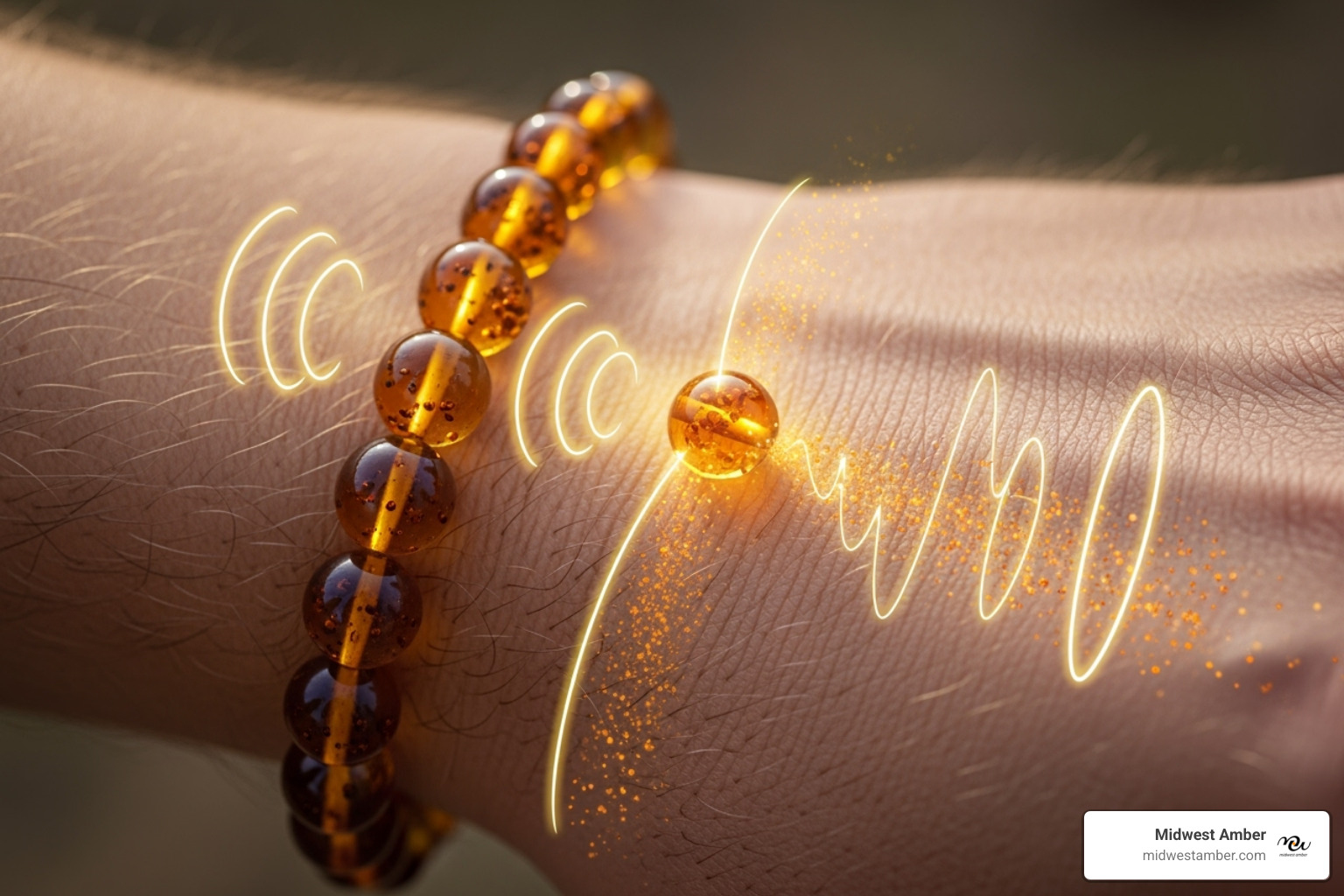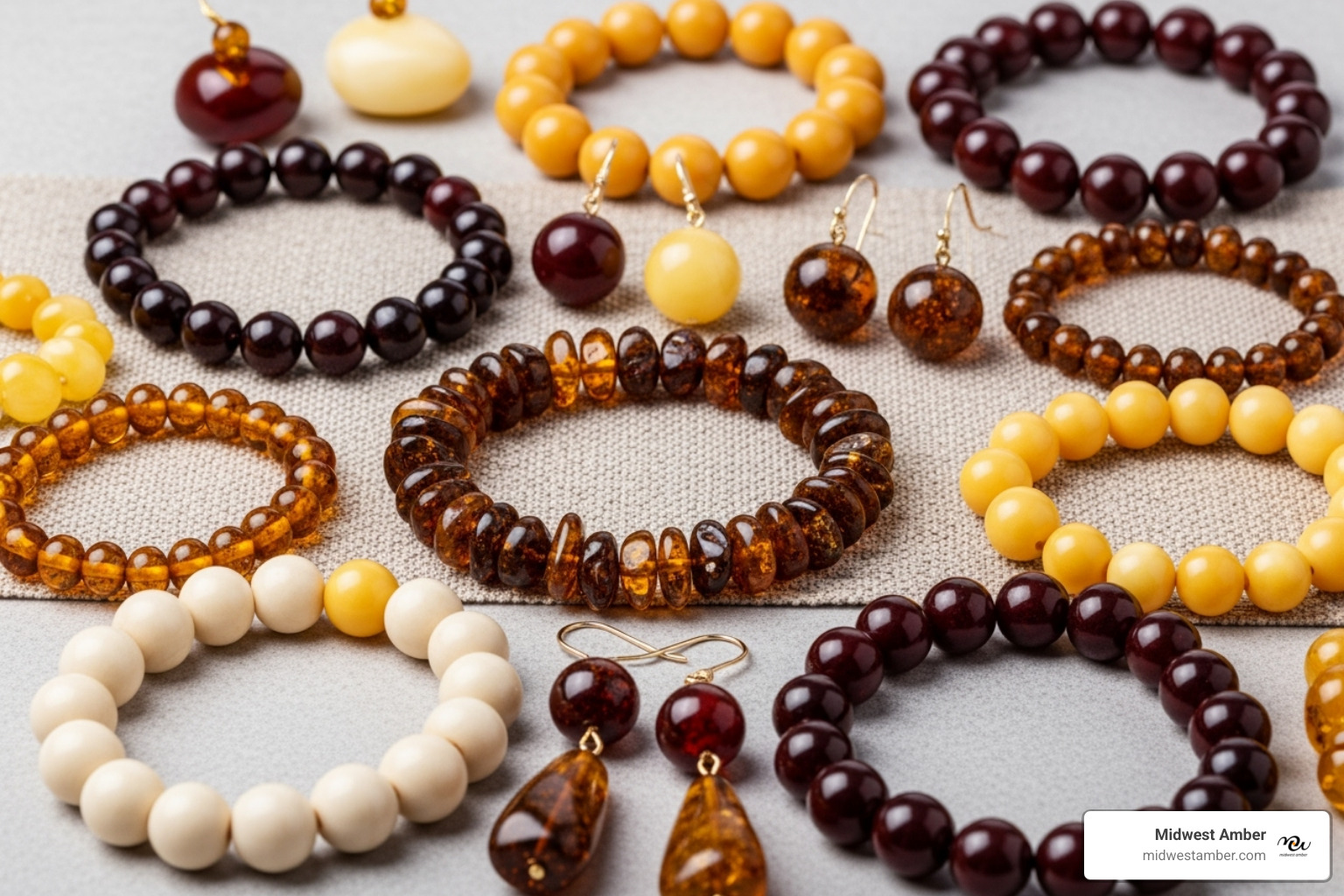A Natural Approach to Joint Pain
Amber for arthritis is a popular natural alternative for joint pain. This ancient fossilized resin, especially Baltic amber, contains succinic acid, a compound believed to have anti-inflammatory benefits when worn against the skin.
Quick Answer for Amber and Arthritis Relief:
- What it is: Baltic amber jewelry containing 3-8% succinic acid
- How it works: Theory suggests body heat releases succinic acid through skin absorption
- Scientific evidence: Limited research shows intact amber beads don't release measurable succinic acid
- Who uses it: People seeking complementary approaches to joint pain management
- Safety: Generally safe to wear, but not a replacement for medical treatment
The appeal is understandable, as arthritis affects millions with chronic pain and stiffness. Many seek alternatives due to the side effects or ineffectiveness of traditional treatments.
But does amber really help with arthritis pain? The answer isn't straightforward.
While amber has been used in folk medicine for centuries, modern science is skeptical. A 2019 study in BMC Complementary Medicine and Therapies found that amber beads don't release succinic acid under normal wearing conditions, and the acid itself didn't reduce inflammation in lab tests.
Despite this, many people report positive experiences, which could be a placebo effect or other unknown mechanisms.
As Gabriel Ciupek, President of Midwest Amber, I've spent years working with genuine Baltic amber. My experience has taught me the importance of providing honest information about amber for arthritis claims while respecting traditional uses and individual experiences.

Understanding Amber and Arthritis
To understand if amber for arthritis might help, we need to explore both the ancient resin and the joint condition itself.
What is Baltic Amber? A Gemstone Forged by Time
Over 45 million years ago, ancient pine forests in northern Europe produced a sticky resin to heal wounds. Over geological time, this resin fossilized into the extraordinary substance we know as Baltic amber.
Baltic amber isn't a traditional gemstone; it's fossilized tree resin, an organic treasure. Known scientifically as succinite, it's found primarily around the Baltic Sea region, where it was carried by ancient rivers.
What makes Baltic amber magical are the inclusions you might find inside—ancient insects or plant matter, perfect time capsules from a prehistoric world. It's like holding a piece of history.
The healing traditions with amber are ancient. Hippocrates, the "Father of Medicine," and the Roman writer Pliny the Younger both documented its medicinal properties. Ancient civilizations believed it could heal, not just for its beauty.
At Midwest Amber, we've spent over 20 years working with genuine Baltic amber, sourcing directly from Poland and Lithuania. Each handcrafted piece carries this incredible history. To dive deeper into amber's journey, check out our guide Beyond the Shine: Exploring the Essence of Natural Baltic Amber.
What is Arthritis? The Challenge of Joint Inflammation
Arthritis isn't a single condition but an umbrella term for over 100 disorders affecting joints. The common thread is inflammation, which causes pain, stiffness, and swelling.
Arthritis can make simple tasks like opening a jar or climbing stairs painful challenges.
The two most common types develop differently. Osteoarthritis, or "wear and tear" arthritis, occurs as the protective cartilage cushioning bones gradually wears away, causing bone to rub against bone.
Rheumatoid arthritis is an autoimmune disorder where the immune system attacks healthy joint tissue. This causes chronic inflammation that can damage bones and deform joints if not managed.
Arthritis affects 1 in 5 adults, making it incredibly common. It's no wonder people explore all avenues for relief, including complementary therapies alongside traditional medicine.
Understanding your arthritis is crucial for managing it. To test your knowledge, try this resource: Take the Arthritis IQ test to grow your knowledge.
This foundation helps us understand the curiosity about natural approaches like amber for arthritis and the importance of examining both traditional beliefs and modern science.
The Science Behind Amber for Arthritis: Succinic Acid Explained
When people discuss amber for arthritis, they're usually referring to succinic acid. This natural substance has captured attention, but the reality is more complex than many believe.
What is Succinic Acid?
Succinic acid is a natural compound already in your body, playing a key role in cellular energy production via the citric acid cycle. It's part of your body's internal power plant.
Baltic amber is special for its high concentration of 3-8% succinic acid—the most of any amber worldwide. This high concentration is why many believe it offers therapeutic benefits.
The compound has a long history. In 1886, Nobel laureate Robert Koch noted its potential positive effects. Traditional medicine has long praised succinic acid for its purported anti-inflammatory and antioxidant properties, believing it could fight free radicals and support the immune system.
It's fascinating that this ancient resin contains a compound so integral to life.
The Theory: How Amber Jewelry May Provide Relief

The theory behind how amber for arthritis might work is simple, though not supported by current science. Proponents suggest the following:
When worn against the skin, body warmth supposedly heats the amber, causing it to release oils containing microscopic amounts of succinic acid. This is then absorbed through the skin (transdermal absorption) and enters the bloodstream.
Once in the system, the theory suggests this succinic acid acts as a natural anti-inflammatory agent, reducing inflammation in joints and easing arthritis pain.
This gentle process appeals to many seeking natural alternatives to traditional pain management. At Midwest Amber, we appreciate the traditional beliefs surrounding amber, but we also believe in being honest about what modern science tells us—which we'll explore next.
A Critical Look: What Does the Scientific Evidence Say?
While traditional stories about amber for arthritis are fascinating, we must look at modern science. As someone with over 20 years of experience with Baltic amber, I believe in being honest about what we know and don't know.
The Claims vs. The Research on Amber for Arthritis
The traditional theory sounds logical: skin warmth releases succinic acid from amber, which is absorbed to reduce inflammation. Many people report real pain relief, and these personal experiences matter.
However, when researchers test these claims in labs, the results don't match traditional beliefs.
The placebo effect might explain some positive experiences, creating genuine symptom improvement. If wearing amber makes you feel better, that's meaningful regardless of the mechanism.
A bigger issue is the lack of clinical trials on amber jewelry for arthritis. We have anecdotal evidence but few rigorous studies, making it hard to separate fact from folklore.
One key study was published in 2019 in BMC Complementary Medicine and Therapies. While focused on teething necklaces, its findings challenge the core claims about amber for arthritis. The researchers asked: Does succinic acid leak from amber beads? And does it reduce inflammation?
You can read the full study here: Scientific research on succinic acid from amber. The results were surprising.
Understanding the Succinic Acid Debate
The Nissen study's findings challenged the theory. Here's a breakdown of what they found:
No measurable succinic acid leaching occurred from intact amber beads, even when heated to body temperature. Only broken beads released tiny, therapeutically insignificant amounts.
This undermines the traditional theory. If succinic acid isn't released, it can't be absorbed to reduce inflammation.
Surprisingly, when applied directly to cells in a lab, succinic acid didn't reduce inflammatory markers. At high concentrations, it was actually pro-inflammatory and toxic to cells, contradicting claims of anti-inflammatory benefits.
Some studies have found that very high concentrations of succinic acid can have immune-suppressive effects, the opposite of "boosting" the immune system.
However, we need more research. One study doesn't invalidate a practice with a long history. Lab conditions may not reflect the real world, and there could be other unstudied compounds or mechanisms at play.
The human body is complex. The benefits people experience may come from something other than succinic acid, such as the ritual of self-care, the comfort of wearing something beautiful, or unfinded mechanisms.
At Midwest Amber, we respect both science and our customers' experiences. We encourage you to think of amber jewelry as a beautiful accessory that might offer complementary benefits—never as a replacement for medical care.
Choosing and Using Amber Jewelry for Wellness
If you're considering amber for arthritis, it's helpful to know your options and how to get the most from your jewelry. With over 20 years in business, we at Midwest Amber are here to guide you.
Types of Amber Products and Their Uses
For amber for arthritis, you have several beautiful options. The key is finding what works for your needs and lifestyle.
Necklaces are a popular choice for upper body concerns like neck, shoulder, and upper spine discomfort. If your arthritis is in these areas, a necklace is a discreet and stylish option to consider.
Bracelets are great for targeting wrist, hand, and arm pain, common areas for arthritis. Many customers report comfort from wearing them, and they are subtle enough for daily use.
Anklets work like bracelets but focus on the lower body, making them ideal for arthritis in the ankles or feet.
Amber oil is an alternative for direct application. It's traditionally used in massage to improve circulation and ease muscle pain, and some use it for skin care.
Amber powder has historical uses in various preparations but is less common today.
We're often asked about raw versus polished amber. Some believe raw amber is more potent, while others prefer polished. Scientifically, there's no proof of a difference, so it's a matter of aesthetic preference.
Explore all your options in our guide: From Raw to Red: A Shopper's Guide to Every Type of Amber Jewelry.
How to Wear and Care for Your Amber Jewelry
Proper wear and care will help you get the most out of your amber jewelry and keep it beautiful.
Direct skin contact is essential for those using amber for arthritis. The traditional theory relies on body heat, so wear it against your skin, not over clothing.
Consistency is key. Amber is not a quick fix. Enthusiasts recommend wearing it for at least four weeks to notice any potential benefits.
When cleaning, use only warm water and a soft cloth. Gently wipe your amber and pat it dry. A chemical-free polishing cloth can restore shine.
Avoid harsh chemicals. Amber is delicate fossilized resin. Soaps, lotions, perfumes, and chlorine can damage it. Remove your amber before showering, swimming, or applying beauty products.
Proper storage is also important. Keep your amber in a soft pouch to prevent scratches and away from direct sunlight, which can fade its color.
For more detailed guidance, see The Ultimate Guide to Buying Real Amber Jewelry: Rings, Earrings, and Beyond.
Safety and Aesthetic Considerations
While amber for arthritis may have wellness benefits, it's also beautiful jewelry. As with any wellness approach, safety is paramount.

Choking hazards are a concern mainly for children's products, but adult jewelry should be well-constructed.
Skin irritation is rare with genuine Baltic amber, but discontinue use if you experience any discomfort.
From a fashion perspective, amber's warm, earthy tones complement any wardrobe. From light yellows to rich browns and dark cherry, there's a shade for every style.
The natural color variations are part of amber's charm. We offer pieces in Milk, Lemon, Honey, Cognac, Cherry, and Multi/Rainbow. Each piece is unique, which is what makes them so special.
Choosing amber for arthritis is a personal decision combining potential wellness with natural beauty. We encourage you to appreciate both aspects while keeping realistic expectations.
Frequently Asked Questions about Amber for Arthritis
With over 20 years in the amber business, we've answered many questions about amber for arthritis. Here are the most common ones.
Does the color or polish of the amber matter for arthritis relief?
This is a popular question: should you choose raw or polished amber, and does color matter for results?
The straightforward answer is that there's no scientific evidence that color or polish makes a meaningful difference for potential arthritis relief.
Some believe raw amber is better, while others prefer polished for its smooth skin contact. However, research has found no significant difference in succinic acid release between them.
The color question is simpler: succinic acid content is not dependent on color. A pale lemon piece has the same basic properties as a rich cherry one.
Our advice? Choose the amber that speaks to you. Your personal connection to the jewelry may be just as important as any other factor.
How long does it take to feel the effects of wearing an amber bracelet for arthritis?
The honest answer is that experiences vary dramatically from person to person.
Some customers notice changes in hours or days, while for others it takes weeks. Some people don't notice any change at all.
There's no magic timeline or guaranteed results. Your body chemistry, arthritis severity, and overall health all play a role in how you might respond.
Many amber enthusiasts suggest wearing your jewelry consistently for at least 4 weeks to give it a fair trial. The idea is that any benefits might build up gradually.
We always remind customers that amber for arthritis isn't a medical treatment. Patience and realistic expectations are key.
Can I wear my amber jewelry in the shower or pool?
Short answer: please don't! It's best to remove your amber jewelry before showering or swimming.
Chlorine is amber's enemy. Pool chemicals can dull its luster, make it brittle, and damage the resin over time.
Shower products aren't much better. Soaps and shampoos can leave residue or contain chemicals that harm the delicate organic material.
For those who believe in amber's therapeutic properties, keeping it chemical-free is important, as exposure might interfere with how it interacts with your skin.
Treat your amber with gentle care. Remove it before swimming or showering, and it will stay beautiful for years to come.
Conclusion: The Golden Gem in Your Wellness Toolkit
Our journey through amber for arthritis reveals a complex story. We've learned that Baltic amber is more than a gemstone—it's a 45-million-year-old time capsule from prehistoric forests, steeped in centuries of belief in its healing powers.
Amber's historical significance is deep, with figures like Hippocrates documenting its use in traditional medicine. This history speaks to its enduring appeal. The theory behind its use for arthritis centers on succinic acid, found in 3-8% concentrations in Baltic amber.
Yet, modern science tells a different story. A 2019 study challenges the belief that succinic acid leaches from amber in meaningful amounts. This creates a tension between anecdotal success and scientific skepticism.
From our 20+ years in the amber industry, we know personal experiences matter. Many customers at Midwest Amber find real comfort wearing our jewelry, whether from a placebo effect, unknown mechanisms, or the psychological comfort of wearing something meaningful.
Amber for arthritis is a bridge between ancient wisdom and modern wellness. It's a non-invasive, beautiful option for those seeking natural health support. Our handcrafted, ethically sourced Baltic amber jewelry provides authenticity and timeless beauty.
The choice to use amber is deeply personal. Some find it complements their arthritis management, while others simply love wearing a piece of natural history. Either way, you're connecting with a golden gem that has captivated humans for millennia.
As Gabriel Ciupek and the team at Midwest Amber, we're committed to providing you with authentic pieces that honor both the beauty of this ancient material and the honest information you need. Whether you're drawn to amber's history, its potential wellness benefits, or its stunning colors, we're here to help you find the perfect piece.
Ready to explore the timeless elegance of Baltic amber? Find the perfect piece with our guide to Dangle and Delight: The Best Amber Necklaces for Every Style. Your golden gem awaits.





Leave a comment
This site is protected by hCaptcha and the hCaptcha Privacy Policy and Terms of Service apply.